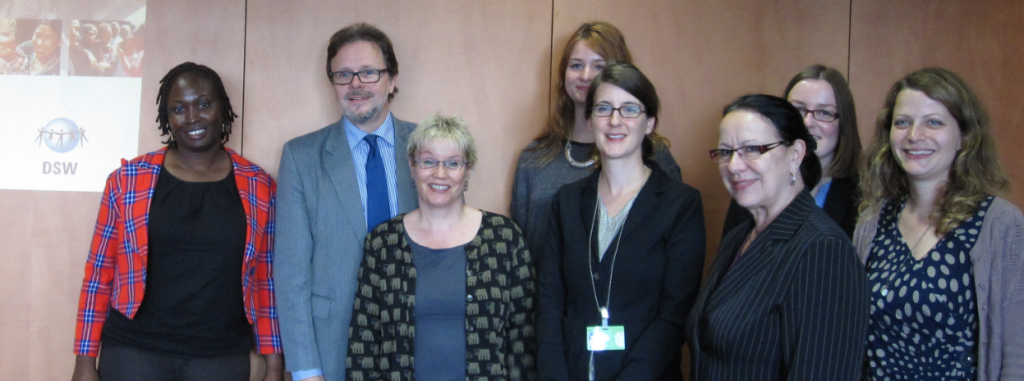Last week, Halima Ali, The Young Adolescents Project (YAP) Coordinator in Kenya, visited Berlin to take part in a special meeting of DSW’s All Party Parliamentary Group on Population and Development in the context of International Day of the Girl Child. While she was here, Halima took the time to talk about progresses achieved via the project and the situation facing very young people living in Kenya today.
Why is there a need to empower Young Adolescents?
There is need to empower young adolescents because the future depends on them. The population structure in Kenya is entrenched in the youth meaning, we have more youth than any other population which stands at almost 32%. Therefore empowering young adolescents will guarantee economic and health development in the country.
What have been the main challenges of implementing the project in Kenya?
There have been a lot of challenges; some of the main ones have been;
- – Illiteracy: Many parents are illiterate therefore myths and misconceptions have affected community engagements and hence this has slowed project progress.
- – Culture: The discrepancy of social cultural issues has continued to suppress the girl child, therefore less opportunities for girls. The focus of Young Adolescents is slowly picking up. Also, the concept of sexual health is a taboo talk hence talking about Young Adolescents issues especially with parents instead of aunts and grandparents is culturally not accepted, this has really affected the project
- – Gender issues: Male involvement has been slow because of gender issues in the area. Fathers can’t buy their girls sanitary towels because they believe it’s the mothers who should buy for their girls’ sanitary towels or use of rags. The fathers also believe that it is a mother’s role to talk to the young adolescents on sexuality issues this has somehow affected male parent involvement in addressing SRHR issues at community level.
- – Poverty: This has led to absenteeism among young adolescent girls because they can’t afford sanitary towels. Poverty has also led to lack of nutritional support therefore poor performance among young adolescents, school drop outs due to poverty has led to early marriages this is because young adolescents’ girls are looking for money to sustain their basic needs.
What surprise success have you witnessed so far?
Setting young adolescents as an agenda for civil society organizations in Kenya is a success story. This has created a platform for key stakeholders like the government and other development partners who are now considering Young Adolescents in their project. This has led to strengthening the multi-sectoral response.
How sustainable is the YAP project?
The project is looking at various strategies for its sustainability
- – Behavioral: Through empowering and equipping young adolescents with knowledge and information on SRHR and developing booklets.
- – County agendas: Setting Young Adolescents agendas as a priority so that the county is including Young Adolescents into their action plans
- – Grants: The grants provided by the project to support in school projects addresses the sustainability issues
- – Structure: Having Community Action committees into place so that young adolescent issues become the centre of Community.
Meeting with Parliamentarians in Berlin
During the meeting with parliamentarians in Berlin, we had a chance to discuss many issues involving the young adolescents and the need to support them. This is because they are often regarded as too young to require information on SRHR. They are often vulnerable especially the girls. They are at risk of early pregnancies, early marriages and school drop outs because of the vicious cycle of poverty and lack of empowerment. Young adolescents’ are always vulnerable and there is need to empower them with the right sexual and reproductive health and rights (SRHR) information. If they are empowered they become informed and are able to make assertive decisions in life.
Why focus on girls alone, what about the boys?
All the projects involve both the boys and girls. YAP project does not only focus on the girl child but also on the boy child this is because, when both are empowered, they will be able to impact positively to their communities. The boys will start knowing their roles towards supporting girls when they grow up .i.e. buying sanitary towels to the girls and supporting women during delivery and also this will reduce gender violence.
What are the receptions of Community leaders in addressing SRHR issues affecting Young Adolescents?
DSW, through its very many community projects, always engage community leaders as part of participatory involvement of the community in addressing SRHR issues. The leaders are trained and equipped with skills and information which they use while addressing the community during community meetings. When the chief addresses the issues at community level, it makes it easier to conduct activities involving all the community members. Hence a positive influence towards addressing SRHR in the community.
For more information about the YAP project, click here.


